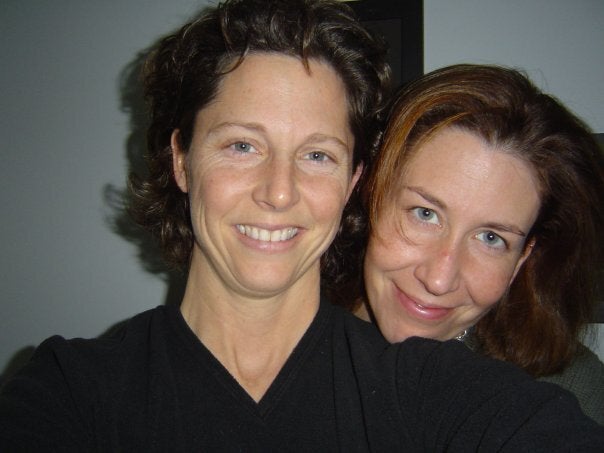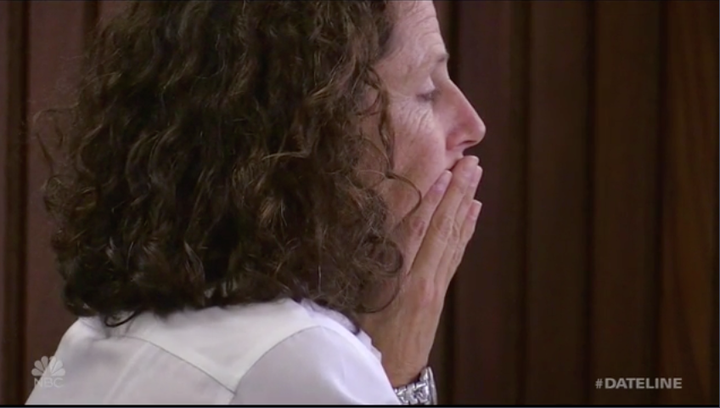This is an excerpt from our true crime newsletter, Suspicious Circumstances, which sends the biggest unsolved mysteries, white collar scandals, and captivating cases straight to your inbox every week. Sign up here.
When the first responders arrived at the house in western Massachusetts and walked downstairs to the basement, they were confronted with a bizarre scene, they later said: A wailing woman sat on the concrete floor cradling her wife’s corpse. Both women and the floor of the basement were covered in paint and blood.
Nineteen months after that rainy evening of March 29, 2010, Cara Rintala was arrested and charged with the murder of her wife, Annamarie Cochrane Rintala. Authorities believe that Cara, dealing with mounting financial pressures, marital discord and a potential custody battle, killed her wife and hours later doused her body and the crime scene with paint in order to mislead investigators.
Cara Rintala has consistently maintained her innocence, and her attorneys did not respond to questions from HuffPost.
Jury selection is currently underway in Cara’s murder trial, and her fate will be determined by a dozen members of her peers. For the fourth time.

The Rintalas, both paramedics, started dating in 2002, got married in 2005 and adopted their daughter as a newborn in 2007. Annamarie, 37, was outgoing and vivacious, while Cara, seven years older, was more reserved. Annamarie worked for American Medical Response in Springfield about 10 miles from their Granby home, while Cara was employed by the Ludlow Fire Department, slightly closer.
Annamarie had worked a night shift on March 28 and was scheduled to work the same shift, starting at 8 p.m., on the day she was killed.
While Annamarie was working on March 28, investigators said that a male friend was visiting Cara at their house, which upset Annamarie. She fired off a series of angry texts to her wife, authorities said, and the couple argued that night and the next morning.
Shortly after Cara returned home from an afternoon running errands with their daughter, now a toddler, at about 7 p.m. on March 29, 2010, she noticed the basement door was open and saw her wife’s bare feet lying at the bottom of the stairs, investigators said she told them. Before going downstairs to check on her, however, the paramedic gathered her daughter and their dog, raced to a nearby house, asked her neighbor to take them and call 911, and rushed back home.
When paramedics arrived, they saw Annamarie’s lifeless body lying faceup across Cara’s lap, they testified. Her eyes were open and her arms were locked in a “hands up” position, and her body was so stiff that it took two first responders to pry her off her “hysterical” wife, they said. “Her entire body moved as one unit, like a board,” a police sergeant testified, referring to the rigor mortis prosecutors argued had set in hours before.
She had bled heavily from her head, said first responders, who also saw puddles, streaks and smears of blood on the basement floor.
What made the scene so startling and confounding, though, was the paint. It was everywhere. Both women and the basement floor were covered in paint, which two paramedics and police officers later described as white, wet and shiny. Photos from the crime scene show an overturned 5-gallon square bucket with paint spilling out of it near Annamarie’s body. Paint covered the floor beneath her body and drenched her thighs. Some of the paint appeared to be pink, first responders said, and an employee for a paint manufacturer later noted that it was designed to turn from pink to white as it dries for painting on white surfaces like ceilings.
Exactly how long the paint had been drying would prove to be key evidence: After two mistrials, a paint manufacturer’s quality engineer testified and likely helped the jury reach a guilty verdict at a third trial — which an appeals judge then reversed after questioning the engineer’s methods.
First responders also said that Annamarie’s body was covered in bruises and that they believed several scalp wounds had caused the heavy bleeding.
That’s not what killed her, though. Any suspicions that Annamarie had died from a tragic fall or accident were thrown out when the medical examiner performed the autopsy.
Annamarie’s cause of death was strangulation, medical examiner Joann Richmond concluded.
Richmond testified at all three of Cara Rintala’s previous trials. She said she counted 23 bruises on Annamarie’s arms, legs and back and she determined that severe injuries on her head had resulted from blunt force — being hit with a blunt weapon or from her head striking a blunt object or surface. She said it was possible Annamarie had suffered the injuries from falling or being pushed down the wooden stairs.
Toxicology tests found no sign of drugs or alcohol in Annamarie’s system, Richmond said.
The bruises on Annamarie’s neck, abrasions on her chin and ruptured capillaries in her eyes indicated that she had been manually strangled, causing her death, Richmond said, although the medical examiner determined her head trauma to be a contributing factor.
One thing the autopsy could not reliably determine, however, was Annamarie’s time of death.

Richmond testified at Cara’s first trial that she estimated Annamarie’s time of death to be between 11:15 a.m. and 1:15 p.m. — well before Cara left the house with their daughter to run errands — but acknowledged that she had listed the time of death as “unknown” in her first autopsy report. In subsequent trials, Richmond estimated Annamarie could have died up to 12 hours before she was found.
But Elizabeth Laposata, a former state medical examiner who taught pathology and laboratory medicine at Brown University and testified for the defense, concluded that Annamarie had died hours later — between 2:30 and 5:30 p.m., she said. By that reckoning, Cara could have been out of the house when Annamarie was killed.
Cara’s movements were summarized in court based on investigators’ accounts of her interviews with state police, surveillance footage, sales receipts and other evidence. The times below are approximate.
March 28, 2010
8 p.m. Annamarie arrived at work for the start of her 12-hour overnight shift. In the hours that followed, Annamarie and Cara sent a number of angry texts to each other. Annamarie was reportedly furious that Cara had a male friend at the house, and at one point texted her wife, “I hate this relationship.”
March 29, 2010
8 a.m. Annamarie left work and soon returned home.
9:30 a.m. Annamarie called her father.
10 a.m. Cara returned home after picking up a few hours of overtime at the fire department.
12:30 p.m. A call was placed from Annamarie’s phone to her aunt in Florida, who did not answer. It was the last recorded activity on her cellphone. (She received numerous texts and calls from her wife that afternoon, but never responded.)
3 p.m. Cara left the house and ran errands with their daughter.
5 p.m. Cara was spotted on surveillance footage at the Holyoke Mall, where she bought T-shirts and socks.
5:47 p.m. In security footage shown to jurors, Cara is seen circling a McDonald’s parking lot for a few minutes before getting out of the truck and throwing several items in a trash can in the rear of the parking lot. Investigators said they retrieved cleaning rags from the trash can, one of which they claimed had a faint bloodstain. They later said that DNA taken from the rag was too degraded to determine whether the stains were even human blood. Cara never explained why she discarded the rags there.
She drove away without buying any food from the restaurant.
5:57 p.m. Cara arrived at the Stop & Shop supermarket, according to the surveillance footage, where a laundry basket and a red bag were seen in the bed of her truck.
6:19 p.m. Cara left the store and drove to a Burger King about five miles away, where she bought dinner for her daughter. The laundry basket and bag were still visible in the security footage, but authorities said these items were not in her truck when she arrived home, and they were never able to locate them.
7:12 p.m. Cara arrived at her neighbor’s house, frantically asking him to take her daughter and dog and call 911.
7:15 p.m. Paramedics arrived at the house.

It was no secret that the couple’s relationship was acrimonious, but the women told authorities in late September 2008 that their marriage was also plagued by violence. Annamarie came to the Granby Police Department and said that Cara had hit her with a spatula and a closed fist. Cara followed shortly afterward, insisting that their fight had been “purely verbal.” Police arrested Cara, who then said Annamarie had assaulted her, showing them a red mark on her neck. Annamarie filed a restraining order against her, which meant Cara couldn’t see their daughter. But in November, Annamarie asked for the case to be dropped. In May 2009, police said they received two 911 calls from the couple’s home. In the first, the dispatcher later testified that she could only hear screaming in the background, with one woman saying, “Just leave, just leave!” Eventually one of the women told the dispatcher that their daughter had accidentally dialed 911.
After another 911 call, the women appeared in court, requesting restraining orders against each other and each asking for primary custody of their daughter, then 2.
“We can have criminal charges going back and forth between both of you, but the only one that’s really going to affect in the long run is your daughter,” the judge said, seemingly exasperated by their sparring. He warned them that if they couldn’t “deal with this as adults,” he would tell the state’s Department of Children and Families that neither woman was “stable enough” to care for their daughter.
“You’re either going to exist in that house until you get this straightened out, or you’re going to look at criminal charges — one or both of you,” the judge said, adding their daughter would be removed from the home in that case.
The couple separated and filed for divorce in 2009 but later withdrew their petitions and attempted to reconcile.
The relationship remained rocky, however. According to video from Cara’s first interview with police following her wife’s death, Cara was candid about their marital problems. She called her wife a “master manipulator” whose impulsive spending — maxing out their credit cards, taking money from Cara’s retirement account and emptying their daughter’s savings account — almost ruined them financially.
An ambulance coordinator who worked with Cara also testified that she had told him Annamarie had withdrawn money from Cara’s retirement account and charged about $25,000 on a credit card she’d opened in Cara’s name.
″She was upset about it,” the co-worker testified, adding that Cara had told him they planned to divorce and let lawyers sort their finances.
“We had a lot of disagreements and were not figuring out how to make them work,” she told police about their relationship. “We were very stressed.”
“I felt bullied in my own home,” Cara said, adding she felt “bamboozled” when Annamarie told police she’d assaulted her.
Cara and Annamarie were both in debt when she was killed. Prosecutors said Annamarie owed $33,000 on her credit card and Cara owed another $35,000, although it’s unclear whether that included the charges Annamarie had made on the credit card she opened in her wife’s name.
Annamarie had also spent up to $20,000 on her friends’ credit cards. Despite their massive credit card debt, the family took a cruise to the Caribbean in February 2010 — the month before Annamarie’s death — after visiting Annamarie’s aunt in Florida. The aunt later testified that the couple argued throughout their stay, and said that at one point, Cara said, “I can’t take this anymore. I want a divorce.”

Cara’s defense tried to deflect suspicion from her to two other people Annamarie had relationships with: a male co-worker and an ex-girlfriend she had reconnected with after the couple filed for divorce in the summer of 2009.
Mark Oleksak, a paramedic who worked with Annamarie, initially lied about his whereabouts the day she was killed, authorities said. A detective testified that at first, he told them he was home all afternoon, but later said he’d gone to a furniture store with his family. In a later interview, after he provided police with access to phone and bank records, he admitted he’d gone to the bank, bought sweatpants at Walmart and purchased cat litter at a grocery store.
Prosecutors pounced on the cat litter purchase, noting that 10 cat hairs had been found on Annamarie’s body, despite the fact that the couple no longer owned cats.
Oleksak, who wasn’t called to testify in Cara’s first trial, took the stand in the second, telling the jury about his relationship with Annamarie. He had been in love with her, he said, and lied to his wife of 30 years about their flirtatious relationship — which he said was never sexual, although he hoped it would be.
Annamarie and Cara got back together in November 2009 after Annamarie broke up with her on-again, off-again girlfriend, Carla Daniele, a Springfield police officer.
While the women were seeing each other during the Rintalas’ separation, Daniele testified that she let Annamarie use her credit card. She accrued more than $10,000 in expenses. Like Oleksak, Daniele did not testify in Cara’s first trial.
Oleksak also had authorized Annamarie to use three of his credit cards, he testified, spending more than $6,000 on one of the cards.
Ultimately, both Oleksak and Daniele were found to have solid alibis on the day Annamarie was killed, the lead investigator in the murder case testified.
Cara was arrested on Oct. 19, 2011, in Rhode Island, where she had moved with her daughter to be closer to her family. She was charged with first-degree murder. Authorities alleged that Cara had beaten and strangled Annamarie, ran a number of errands afterward to establish an alibi, and doused her wife’s body and the crime scene with paint before first responders arrived.
Prosecutors argued that rigor mortis had set in when first responders arrived, proving that Annamarie had died well before Cara left the house.
Cara’s first trial, in early 2013, ended in a hung jury. So did her second trial in early 2014. It wasn’t until her third trial, in the fall of 2016 — after several people testified who hadn’t previously taken the stand — that a jury returned with a guilty verdict. She was sentenced to life in prison, where she spent several years before her conviction was overturned on appeal.
David Guilianelli, a quality engineer for the company that manufactured the paint found at the crime scene, was one of those previously unheard by a jury. He testified as an expert witness in the third trial that, based on his experience and experiments he conducted for the case, the paint was deliberately poured, not spilled, by someone about 30 minutes before first responders arrived — long after medical examiners determined that Annamarie had died.
His testimony might have persuaded the jury, which found Cara guilty, but not the appeals court. It agreed with the defense’s argument that Guilianelli was not qualified to testify because the experiments he conducted were novel, unreliable, incomplete and inconsistent, and his findings and conclusions were subjective, based on anecdotal observations rather than reliable methodology.
The appeals court determined that Guilianelli’s testimony “was significant and likely swayed the jury’s verdict,”
and ruled to vacate the judgment against Cara.
Prosecutors were determined to try her a fourth time.
“That paint had just been poured,” First Assistant Hampshire District Attorney Steven Gagne insisted in a news conference after the verdict was overturned, calling the decision “profoundly disappointing.”
He said prosecutors would retry the case “not because we’re in it for the win, or the glory or the fame, but because it’s the right thing to do. We’re seeking justice for Annamarie and her family.”
Opening statements are expected to begin this week for Cara’s fourth trial in Hampshire Superior Court in Northampton, presided over by Judge Frank Flannery. Now 56, she has been free on bail and living with her parents and now-teenage daughter in Rhode Island since November 2021.
Cara has always maintained her innocence. She did not testify in previous trials, and it’s unclear whether she’ll take the stand in her own defense in this trial.
Need help? In the U.S., call 1-800-799-SAFE (7233) for the National Domestic Violence Hotline.

